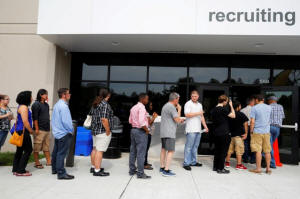U.S. job growth cools as labor market nears full
employment; wages up
 Send a link to a friend
Send a link to a friend
 [January 16, 2018]
By Lucia Mutikani [January 16, 2018]
By Lucia Mutikani
WASHINGTON (Reuters) - U.S. job growth
slowed more than expected in December amid a decline in retail
employment, but a pick-up in monthly wage gains pointed to labor market
strength that could pave the way for the Federal Reserve to increase
interest rates in March.
Nonfarm payrolls rose by 148,000 last month after a surge of 252,000 in
November, the Labor Department said on Friday. Retail payrolls fell by
20,300 in December, the largest drop since March, despite reports of a
strong holiday shopping season.
The unemployment rate was unchanged at a 17-year low of 4.1 percent.
Economists polled by Reuters had forecast payrolls rising by 190,000 in
December. The economy needs to create 75,000 to 100,000 jobs per month
to keep up with growth in the working-age population.
"We do not think that today's employment report will keep the Federal
Reserve from tightening again at the March policy meeting, given other
strong recent economic data," said David Berson, chief economist at
Nationwide in Columbus, Ohio.
Job growth surged in October and November after being held back in
September by back-to-back hurricanes, which destroyed infrastructure and
homes and temporarily dislocated some workers in Texas and Florida.
Taking the sting out of the moderation in job gains, average hourly
earnings rose 9 cents, or 0.3 percent, in December after a 0.1 percent
gain in the prior month. That lifted the annual increase in wages to 2.5
percent, from 2.4 percent in November.

Prices of U.S. Treasuries fell on the employment report while the dollar
<.DXY> rose marginally against a basket of currencies. Stocks on Wall
Street were trading higher.
Employment gains in December were below the monthly average of 204,000
over the past three months. Job growth is slowing as the labor market
nears full employment, but could get a temporary boost from a $1.5
trillion package of tax cuts passed by the Republican-controlled U.S.
Congress and signed into law by President Donald Trump last month.
The lift from the fiscal stimulus, which includes a sharp reduction in
the corporate income tax rate to 21 percent from 35 percent, is likely
to be modest as the stimulus is occurring with the economy operating
almost at capacity. There are also concerns the economy could overheat.
NEAR FULL EMPLOYMENT
Data ranging from housing to manufacturing and consumer spending have
suggested solid economic growth in the fourth quarter, despite a
widening of the trade deficit in both October and November, which could
subtract from gross domestic product.
In a separate report on Friday, the Commerce Department said the trade
gap widened 3.2 percent in November to $50.5 billion, the highest level
since January 2012.
The deficit was boosted by record high imports, which offset the highest
exports in three years. The economy grew at a 3.2 percent annualized
rate in the third quarter.

[to top of second column] |

Job seekers line up to apply during "Amazon Jobs Day," a job fair
being held at 10 fulfillment centers across the United States aimed
at filling more than 50,000 jobs, at the Amazon.com Fulfillment
Center in Fall River, Massachusetts, U.S., August 2, 2017.
REUTERS/Brian Snyder/File Photo

For all of 2017, the economy created 2.1 million jobs, below the 2.2 million
added in 2016. It was the seventh year in a row that the economy generated more
than 2 million jobs.
Economists expect job growth this year to slow to well below the 2017 monthly
average of 170,000 as the labor market hits full employment, which will likely
boost wage growth as employers compete for workers.
"Almost every person ready, able and willing to work now has a job," said David
Kelly, chief global strategist at JPM Asset Management in New York. "Meeting the
labor demand of 2018 will require hiring those less willing, and enticing them
into the labor market will probably require stronger wage growth."
Economists are optimistic that annual wage growth will top 3.0 percent by the
end of this year. The unemployment rate declined by seven-tenths of a percentage
point last year.
The jobless rate for African-Americans fell to a record low of 6.8 percent in
December.
Economists believe the overall unemployment rate could drop to 3.5 percent by
the end of this year, which would be the lowest since the late 1960s. That could
potentially unleash a faster pace of wage growth and translate into a much
stronger increase in inflation than currently anticipated.
That, according to economists, would force the Fed to push through four interest
rate increases this year instead of the three it has penciled in. The U.S.
central bank raised borrowing costs three times in 2017.
Employment gains were largely broad-based in December. Construction payrolls
increased by 30,000 jobs, the most since February, reflecting recent strong
increases in homebuilding. Manufacturing employment increased by 25,000 jobs.
Manufacturing is being supported by a strengthening global economy and a
weakening dollar. Employment in the utilities sector fell for a second straight
month.
General merchandise stores payrolls tumbled by 27,300 in December, with
employment at clothing stores dropping by 3,800 jobs. For all of 2017, retail
employment dropped by 67,000 jobs after rising by 203,000 in 2016.

Further job losses are likely this year as major retailers, facing stiff
competition from online sellers like Amazon.com Inc <AMZN.O>, close stores.
Sears Holdings Corp <SHLD.O> said on Thursday it was shuttering 103 unprofitable
Kmart and Sears stores. Macys Inc <M.N> also announced 11 store closures, which
could leave 5,000 workers unemployed.
"Employment in retail trade is now the lowest it has been in almost 50 years as
a percentage of total employment, and there is nothing to suggest that trend
will reverse," said Eric Winograd, a senior economist at AllianceBernstein in
New York.
(Reporting by Lucia Mutikani; Editing by Paul Simao)
[© 2018 Thomson Reuters. All rights
reserved.] Copyright 2018 Reuters. All rights reserved. This material may not be published,
broadcast, rewritten or redistributed. |